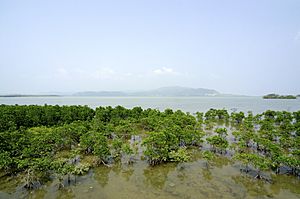Rhizophoraceae facts for kids
Quick facts for kids Rhizophoraceae |
|
|---|---|
 |
|
| Young Rhizophora mangle, a mangrove | |
| Scientific classification |
|
| Kingdom: | Plantae |
| Clade: | Tracheophytes |
| Clade: | Angiosperms |
| Clade: | Eudicots |
| Clade: | Rosids |
| Order: | Malpighiales |
| Family: | Rhizophoraceae R.Br. in Flinders |
| Genera | |
|
See txt |
|
 |
|
The range of Rhizophoraceae
|
|
The Rhizophoraceae is a special family of flowering plants. It includes 149 different species of plants. These species are found in 16 main groups called genera. Most of these plants grow in the warmer parts of the Old World, which means places like Africa, Asia, and Australia.
The most famous members of this plant family are the amazing mangrove trees. These trees are super important for coastal areas around the world.
Contents
What are Rhizophoraceae?
The Rhizophoraceae family is a group of plants that are mostly trees or shrubs. They are known for living in tropical and subtropical areas. Many of them grow in wet, swampy places.
Meet the Mangroves
Mangroves are the most well-known plants in the Rhizophoraceae family. They are unique trees that can grow in salty water. This is something most plants cannot do! Mangroves often form dense forests along coastlines.
Living in Saltwater
Mangrove trees have special ways to deal with salt. Some of them can block salt from entering their roots. Others can take in salt and then push it out through their leaves. They also have special roots that grow above the water. These roots help them breathe in muddy, oxygen-poor soil. These roots can look like stilts or knees sticking out of the mud.
How Mangroves Help
Mangrove forests are like natural protectors for coastlines. They help stop erosion from waves and storms. Their tangled roots also provide safe homes for many sea creatures. Young fish, crabs, and other animals hide and grow among the roots. This makes mangroves very important for ocean life.
Where Do They Grow?
Most Rhizophoraceae plants, especially mangroves, live in tropical and subtropical regions. You can find them along the coasts of Africa, Asia, Australia, and parts of the Americas. They prefer warm climates and muddy shores.
How Do They Reproduce?
Many mangrove species have a unique way of reproducing. Their seeds start to grow while they are still on the parent tree. This means the seeds sprout into small plantlets before they even drop. These plantlets, called propagules, are shaped like long pencils. When they fall into the water, they can float for a long time. They can travel far before finding a good spot to root and grow. This helps them spread to new areas.
Why Are They Important?
Rhizophoraceae plants, especially mangroves, are vital for many reasons. They support diverse ecosystems, providing food and shelter. They protect coastlines from damage. They also help clean the water by trapping sediments. For people, mangroves can provide wood and other resources. They are truly amazing and important plants!
See also
In Spanish: Rhizophoraceae para niños


